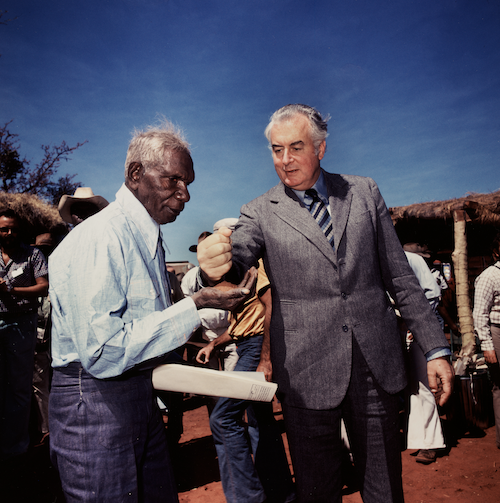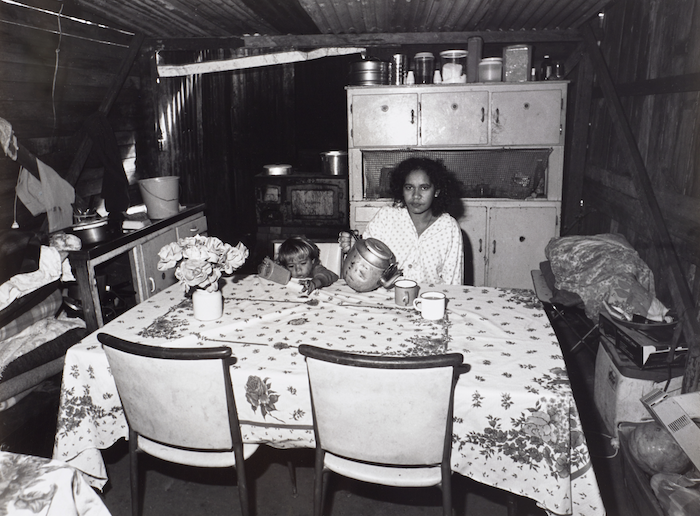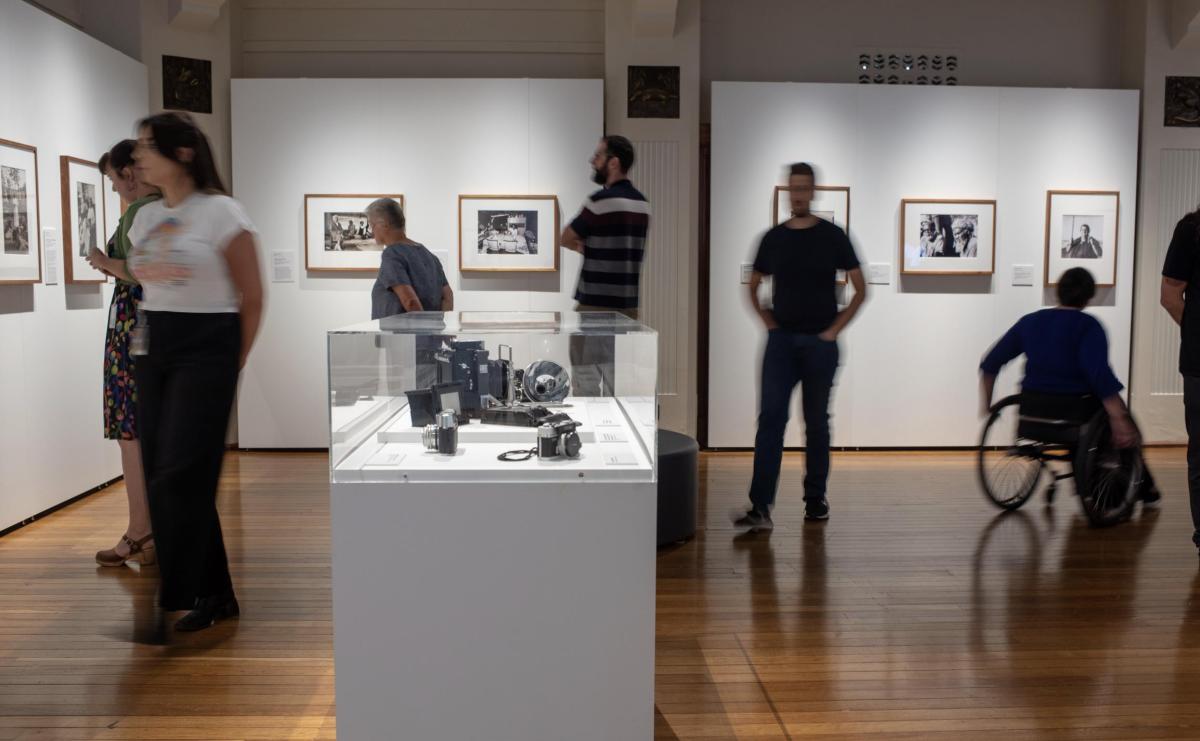Survey exhibitions offer a time to remember, and pay a nod to the artworks that have shaped a society. Indigenous photographer Mervyn Bishop is one such artist who has played a significant role in creating Australian narratives – and perhaps the first Aboriginal artist of his generation to offer an alternate view. He was certainly the first Indigenous photojournalist, and his work in the 1970s was particularly important as our nation turned to a new language of self-determination.
Mervyn Bishop is an Art Gallery of NSW (AGNSW) touring exhibition, with this exhibition’s last stop perhaps its best.
‘Indigenous photographer Mervyn Bishop is one such artist who has played a significant role in creating Australian narratives…’
Curated by AGNSW Assistant Curator, Aboriginal and Torres Strait Islander Art, Coby Edgar, the exhibition has morphed and changed considerably for its current iteration at the National Film and Sound Archive (NFSA) in Canberra, making use of their unique holdings of sound and moving image.
It adds a layer of richness that sparks this exhibition into life. Mervyn Bishop said of this new iteration: ‘…there are not many exhibitions that combine photography with mixed media, and I think visitors will be amazed by this combination.’
The sense of journey is immediately felt entering the exhibition. It beautifully weaves photographs drawn from the AGNSW collection, with objects from Bishop’s personal archive – vitrines of cameras and even a mock-up of Bishop’s darkroom – with elements of sound and film.
Read: Exhibition Review: Redemption of Colour, Canberra Glassworks
The exhibition’s design allows for an intimacy with the work for the viewer, and at no time feels overwhelming, despite the enormity of the content.
Didactics (wall texts) pepper the exhibition – both offering a historical framework and Bishop’s own words. It helps shift this exhibition from a more formal gallery-style documentary driven display, to a very nuanced visitor experience that taps into the thorny moments that have shaped Australia today, but are masked with a velvet glove of celebration.
That was the incredible gift of Bishop’s images – that soft, yet solid voice. Take for example his 1975 photograph of Former Prime Minister Gough Whitlam pouring red earth into Gurindji leader Vincent Lingiari’s hand in the aftermath of the Wave Hill strike, which became an iconic image of the Aboriginal land rights movement.

Mervyn Bishop Prime Minister Gough Whitlam pours soil into the hands of traditional land owner Vincent Lingiari, Northern Territory 1975. Art Gallery of New South Wales Hallmark Cards Australian Photography Collection Fund 1991 © Mervyn Bishop/ Department of the Prime Minister and Cabinet; Photo: AGNSW.
In a new inclusion to the survey, Warwick Thornton’s filmic portrait, Photographic memory: a portrait of Mervyn Bishop (1999) sits central to the exhibition and provides background to several of his iconic award winning images and discusses his role as an Aboriginal photographer during a time of great political and social change.
Bishop’s journey with photography started early. His mother dabbled with her own camera, but it was a chance encounter with a school friend’s father’s dark room that the magic took hold for Bishop.
Spanning 60 years of work, overall the exhibition includes images from Mervyn’s time as as a cadet journalist with the Sydney Morning Herald (from 1963), staff photographer for the Department of Aboriginal Affairs (from 1974), and his photographs of influential Australian figures like activists Lowitja (Lois) O’Donoghue and Oodgeroo Noonuccal (Kath Walker), boxer Lionel Rose, performer Jimmy Little and the first Aboriginal Dancer to join the now Sydney Dance Company, Roslyn Watson.
Read: Exhibition Review: PHOTO 2021
‘He became a shining instance of Aboriginality. He was a fighter, he was famous…’ Bishop says of Rose.
Several of Bishop’s images sit alongside recordings, such as Robin Hughes and Linda Kruger’s 1998 interview with Jimmy Little, where he talks about stardom and the profound impact that his Aboriginal heritage had on his life and music.
A highlight also is a three-channel video montage taken from raw 16mm film footage of Lionel Rose in Tokyo (1968), shot days before winning the world title.
An image that sums up Bishop’s compassion, celebration and strength as a storyteller is, Girl pours tea, Burnt Bridge (1988), capturing the unwavering pride of a young woman in her home, regardless of the conditions.

Mervyn Bishop Girl pours tea, Burnt Bridge 1988. Art Gallery of New South Wales Hallmark Cards Australian Photography Collection Fund 1991 © Mervyn Bishop, Photo: AGNSW.
There is a strong celebration of Aboriginal women across the exhibition, as well as a feeling of great empathy, joy and kinship in many of his images. It really is a wonderful experience to walk through these frames of life – and to consider them within our own time of political and social history.
Part of that empathetic lens reaches back to Bishop’s time as a youth when he ‘found his eye’ – his distinctive framing of empathy through the lens. From his youth he started photographing life around him – football games, the neighbourhood, the church community. At just 14 he was encouraged by a sub-editor at the Sydney Morning Herald to continue his passion for photography.
He became Australia’s first Aboriginal press photographer, and in 1971 won the Nikon Press Photographer of the Year Award with his front-page photograph Life and Death Dash (1971) – the image of a nun clutching a young boy and running in desperation to get medical attention.
‘There is a strong celebration of Aboriginal women across the exhibition, as well as a feeling of great empathy, joy and kinship in many of his images.’
The boy had consumed his mother’s prescription medication, but has been frequently mistaken as depicting the impact of religious missions and actions from the Stolen Generations.
Bishop left Canberra in 1979 to return to The Sydney Morning Herald until 1986.
This exhibition is not the first nod to Bishop’s career. In 1991, the solo exhibition – which was his first – In Dreams: Mervyn Bishop Thirty Years of Photography 1960–1990 was curated by Tracey Moffatt for the Australian Centre for Photography, Sydney, before touring nationally and internationally.
This is a very different show, and comes at a very different time, when the world this past year and been forced to face the conversation of Black Lives Matter. This exhibition is a very worthy reminder.
It is showing at NFSA ahead of former Reuters journalist Tim Dobbyn’s upcoming biography on Bishop, tentatively titled A Handful of Sand.
Rating: 4 ½ stars out of 5 ★★★★☆
Mervyn Bishop
National Film and Sound Archive, Canberra
An Art Gallery of New South Wales touring exhibition, presented in collaboration with the NFSA
5 March – 1 August 2021
$13/$10





